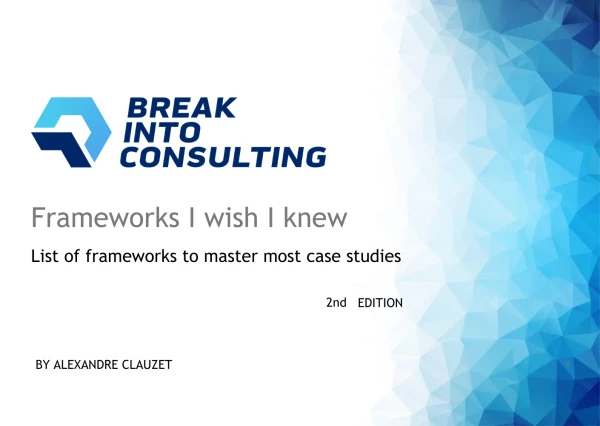I'm up to the part in studying that I am trying to understand how to structure my notes. I know that you should usually structure your notes in a few main buckets and that these buckets should be following MECE. I also know that under each bucket you ask a bunch of questions corresponding to the bucket to better understand say the "company". However, what I am confused about is first how to come up with the main buckets and second to make sure that these buckets are MECE. If anyone has any insight into this it would be greatly appreciated!
I'm stuck on understanding how to structure my notes


Hi Brian,
Structure is key to succeed in interview.
In general, the philosophie is "a unique client issue requires a unique approach", so let's avoid using strandard framework learned from the book. They are a good way to start learning for very beginners but are too theoretical to properly fit with a real case.
Quick tips to build a MECE structure :
1. Make sure you capture the key topics : I highly recommand here to put yourself in your clients shoes and think about the topic you need to cover before making a reasonable decision. This will facilitate the identification of key topics, and somehow will help to prioritize them
2. Make sure you don't cover unrelevant topics : this is particularly happening when you try to apply standard framework, and force some "blocs" in the structure. In reality, depending on the situtation and the issue, the answer to provide can vary a lot and that's why you need to really think by yourself and challenge the topics you want to cover with the following question " if I spend time on this topic, will this bring absolutely key information for the final recommandation". if the answer is not clearly yes, then you should drop the topic.
Hope this help, don't hesitate to reach me, I have developped a full set of exercice dedicated to working the structure.
Best
Benjamin

Dear Brian,
in general a good structure can be evaluated by a certain depth and breadth. The “depth” should be at least 3-4 levels while the “breadth” should cover the entire solution space. You can cross-check this with the MECE principles (For details see respective article on Preplounge), but the CE (collectively exhaustive) part is basically defining your breadth.
Finally, make sure to check for inter-linkages in your structure and point them out.
Simon

Note taking is of course a critical piece of a strong case delivery, so it will pay off to practice this early on in your preparation.
Whatever system you chose (and practice), it needs to fulfill 3 main purposes:
- Allow you to note down the critical data and information you hear during the case prompt and have the readily available whenever you need them
- It needs to enable you to note down an initial framework and track the execution against it
- It should provide room to store your key insights (1-2 numbers or 1 short bullet point per branch of your framework)
There are certainly many different styles of note taking that provide these three functions, so you should find our which one works for you and enables you to focus on the case execution, rather than the note taking. Keep in mind that you should practice this system early on in your journey, so you are comfortable with this method when you go into the interviews.
Find below a screenshot of the notetaking system that works for me personally. In this system, I first draw one vertical and one horizontal line. Then I use the column on the left side to take the initial notes during the case prompt and clarifying questions. Then I write down the key question of the case in the top row and develop the framework in the main area on the page.
During the case, I scribble less important stuff on separate pages (e.g. notes during the quant part). However, I will write down the key insights of each branch of the framework at the bottom of my main page. That way, when I get to the recommendation, I can simply read the notes from left to right to have the supporting arguments for the case recommendation.













